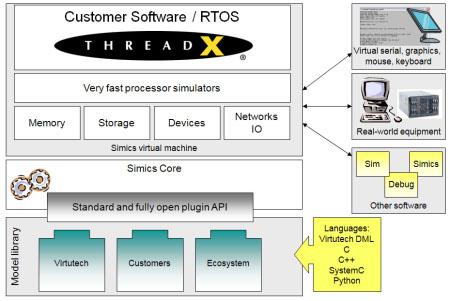Virtual system mimics superscalar SoC
Oct 28, 2008 — by Eric Brown — from the LinuxDevices Archive — viewsVirtutech has announced a virtual system for simulating the Renesas Technologies SH-4A superscalar system-on-chip (SoC). Based on its Simics simulated development platform, the SH-4A simulator has been tested on Express Logic's ThreadX real-time operating system (RTOS), but should also work with Linux, says the company.
Jointly developed with Express Logic, the Simics-based simulator enables customers to get started with software modeling of custom ASICs (application specific integrated circuits) based on the Renesas SH-4A core, before the part arrives, says Virtutech. Engineers can develop, debug, test, and run their software application stack on a virtual representation of their target hardware.
Introduced in 2002, Virtutech's Simics is a mature “Virtual Software Development” (VSD) board simulation environment that has been used to simulate processors such as Freescale's MPC8572E PowerQUICC III and forthcoming QorIQ processors. It also supports ARM, PowerPC, and x86 architectures.
Simics is positioned as providing “whole board” simulation with “cycle-accurate” instruction-set emulation, for meaningful hardware evaluation as well as software evaluation. Simics is said to be capable of running unmodified production-quality binaries, and can be used with third-party software development tools.

The Simics simulator for the SH-4A has been tested with ThreadX only,
but should work with other compatible OSes, including Linux
(Click to enlarge)
Simics does not require the OS to be paravirtualized, (i.e. adapted to run on the simulated processor), says Virtutech. “That is the beauty of it,” wrote Michel Genard, Virtutech VP of Marketing, in an email interview. “Simics has the ability to run unmodified software from the driver, OS, stack, and application. From a software perspective, it doesn't even know that it is running on a virtual platform.”
According to Genard, Virtutech's SH-4A simulator has only been tested on ThreadX so far, but that it should also support any other OS that supports the SH-4A. Likely candidates there would be Linux and Windows CE.
SH-4A
Announced in 2004, the SH-4A core is frequently used in SoCs and ASICs targeting consumer electronics products. It integrates 32KB each of instruction and data cache, 16KB of on-chip RAM, and a 108MHz 32/64-bit bus for connections to external SDRAM. The core also integrates a powerful single-/double-precision FPU (floating point unit) with hardware sine/cosine and vector math accelerators.
Linux-compatible Renesas processors running the SH-4A core include the SH-MobileR2 SH7723 SoC, which shipped in April and is aimed at car navigation systems and PNDs (personal navigation devices). The SH-MobileR2 SH7723 incorporates a 400MHz SH-4A CPU core, 256KB secondary cache, H.264 codec, 2D graphics accelerator, USB 2.0 support, plus SD and ATAPI controllers, says Renesas. Other SH-4A-based SoCs include the SH-MobileR SH7722, which integrates a 266MHz SH4AL-DSP core with hardware terrestrial digital broadcast (DVB-T) codecs and targets portable media players, video-VoIP devices, and TV-enabled navigation systems.
Stated Brian Davis, director of the MPU group of Renesas Technology America, “Renesas customers migrating to next-generation SH-4A microprocessors can begin software development today using the Virtutech Simics platform. It's an ideal match for real-time applications involving the SH-4A.”
Availability
The SH-4A simulator for ThreadX is shipping now, says Virtutech, which did not disclose a price.
This article was originally published on LinuxDevices.com and has been donated to the open source community by QuinStreet Inc. Please visit LinuxToday.com for up-to-date news and articles about Linux and open source.